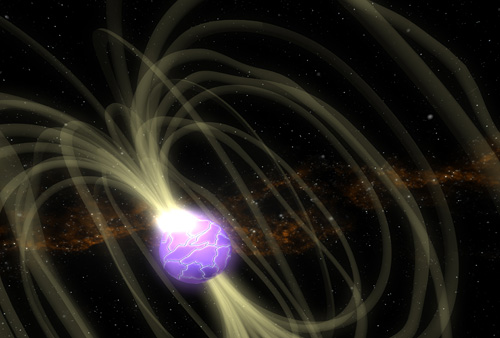Key Takeaways:
An international collaboration of 20 institutions detected the most powerful cosmic blast outside our solar system ever to be recorded: It is 100 times brighter than the previous record-holder. The blast was so powerful, it gave off more energy in a tenth of a second than the Sun emits in 100,000 years.
The blast originated from a highly magnetized neutron star called a magnetar. The star, SGR 1806-20, is on the other side of the galaxy, 50,000 light-years away, in the constellation Sagittarius.
As the intense magnetic fields of the magnetar shifted and reconnected inside the star — imagine an earthquake of magnetic fields — a wave of gamma rays flew away from the magnetar. Radiation hit Earth with such force and energy that Earth’s ionosphere (the upper layer of the atmosphere) was distorted.
Neutron stars are once very massive stars that have gone supernovae and now are left with the mass equivalent to our Sun in a sphere only 15 miles wide. They have highly magnetic fields — a trillion times that of Earth — and rotate at extreme velocities; SGR 1806-20 completes one revolution in 7.5 seconds.
Magnetars are neutron stars with magnetic fields 1,000 stronger than that of an ordinary neutron star. Out of the millions of neutron stars in the Milky Way, scientists know of only a dozen magnetars.
SGR 1806-20 is a member of an even more specific group of objects called soft gamma-ray repeaters (SGRs). These objects are so named because they occasionally release gamma-ray flashes with a million times more energy than our Sun. Out of the dozen known magnetars, four are cataloged as SGRs.
Satellite observatories — NASA’s Swift (launched November 20, 2004) and NASA’s High Energy Solar Spectroscopic Imager (RHESSI) — were saturated by gamma rays and X rays from SGR 1806-20’s December 27, 2004, blast.
In the explosion, the initial radiation was a spike of high-energy gamma rays. This was followed immediately by a tail of X rays lasting 7 minutes with an oscillating pattern repeating every 7.5 seconds — the time it takes for the magnetar to complete one revolution. The gamma rays overloaded instruments on the space-based observatories, however, the instruments were able to recover quickly enough to observe the X-ray radiation.
Ground-based radio observatories in the United Kingdom, India, the Netherlands, Australia, and the United States recorded the blast’s “afterglow” — radiation that can be observed for days to months after the initial blast. As gamma rays flew from the magnetar, the “material violently collided with surrounding gas, producing a glowing, expanding bubble,” according to Bryan Gaensler of the Harvard Smithsonian Center for Astrophysics (CfA) and lead researcher for the observations of SGR 1806-20 made by the Very Large Array in New Mexico. That bubble glows in the radio waves. By looking at the radio wavelengths, astronomers can confirm how much energy was released and what caused the blast. They are finding this bubble is expanding much faster than expected, at one-quarter the speed of light.
Astronomers classify gamma-ray bursts (GRBs) in two groups: short-duration, typically lasting less than 2 seconds, and long-duration. Scientists think long-duration GRBs occur when a massive star collapses into a black hole, but the processes that produce short-duration GRBs are still unknown.
The SGR 1806-20 blast could shed light on the origins of short-duration GRBs. If an SGR magnetar in another galaxy undergoes magnetic-field shifting, astronomers could see the initial gamma-ray spike without the following X-ray oscillations, because the oscillations would be too faint to be seen so far away.
Understanding the processes behind GRBs, magnetars, and other extreme objects in the universe is a high priority for astronomers. NASA’s Swift observatory is designed to look at hundreds of GRBs over the course of its lifetime. When a GRB goes off, Swift will rotate into position to observe the GRB in gamma-ray, X-ray, and optical radiation.
The fact that within 2 weeks of being operational, Swift was able to observe such an event is amazing. David Palmer of Los Alamos National Laboratory in New Mexico said it best: “This might be a once-in-a-lifetime event for astronomers, as well as for the neutron star. … Sometimes being lucky is the best strategy.”











